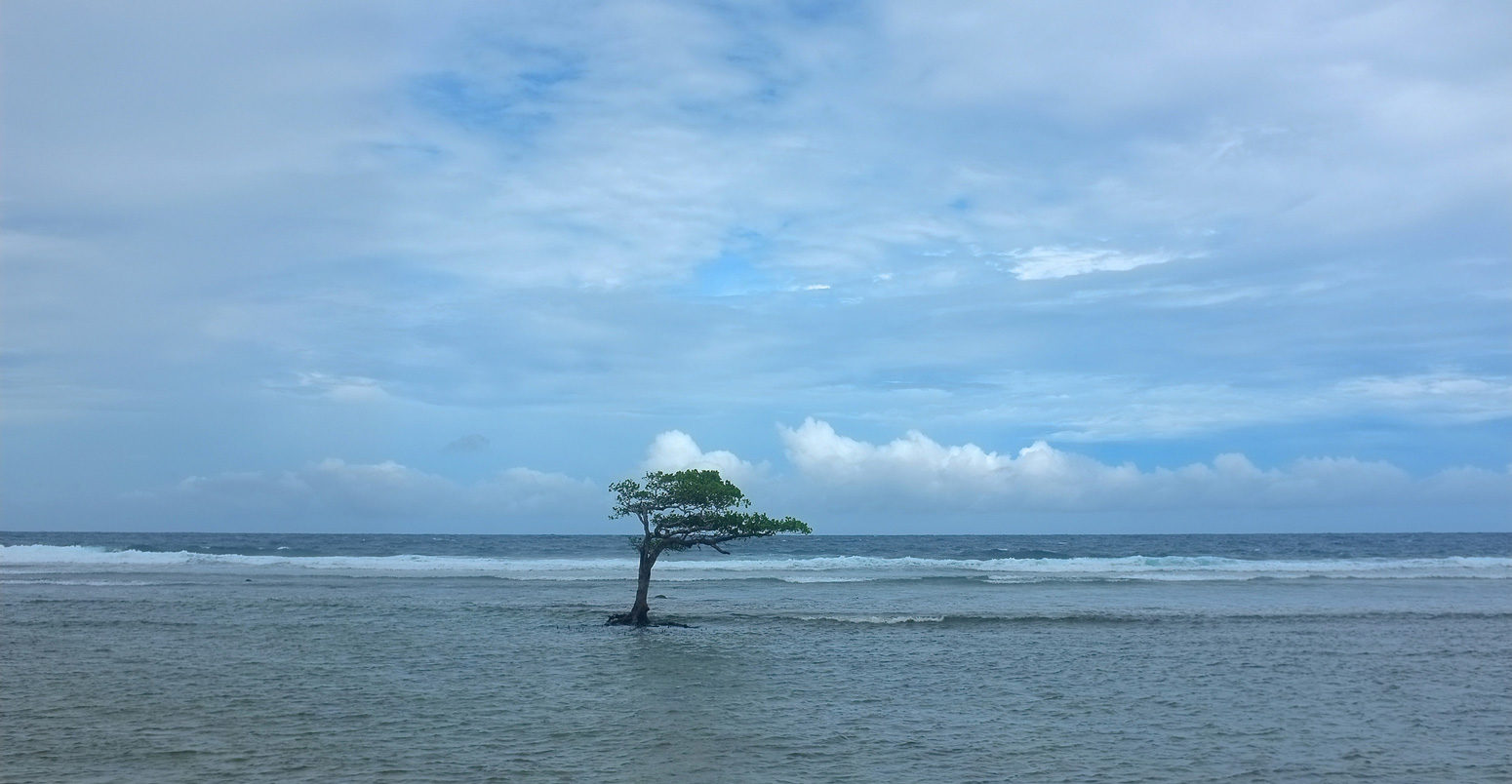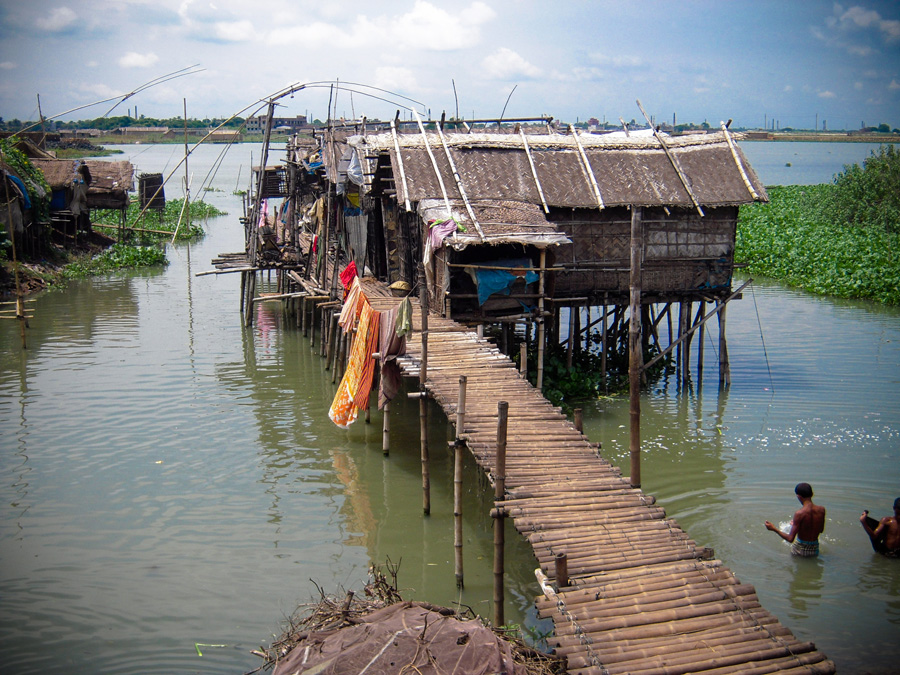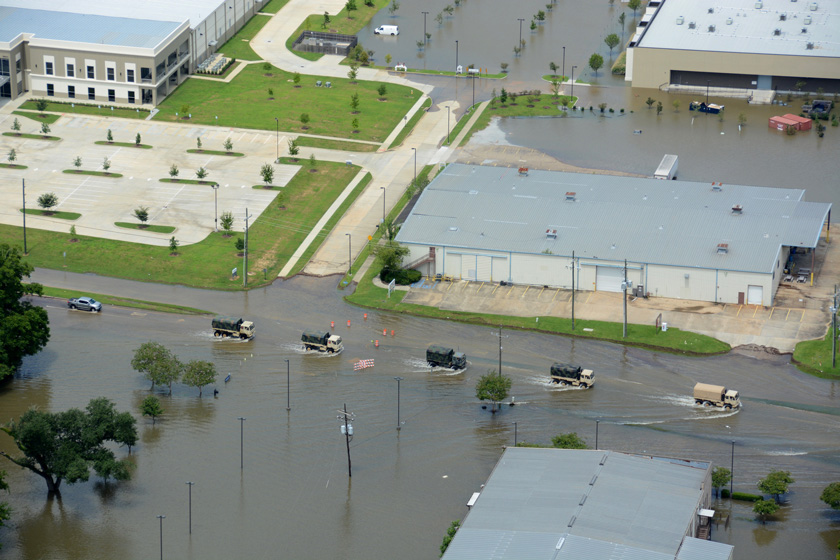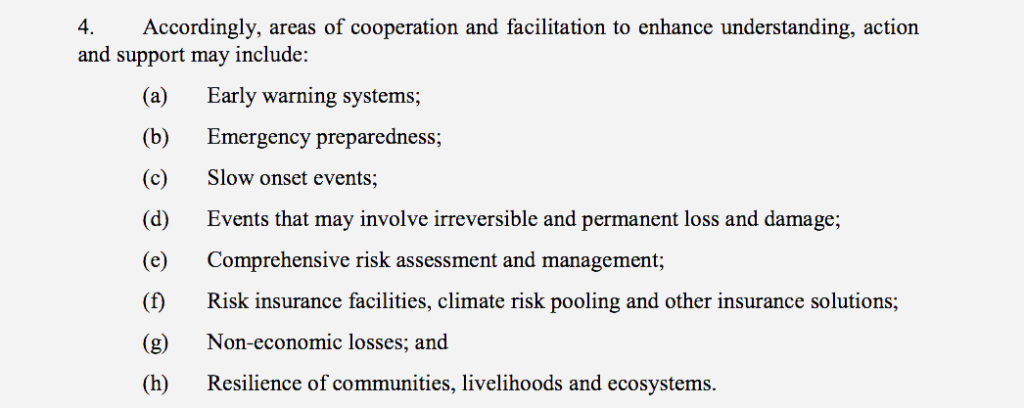
Explainer: Dealing with the ‘loss and damage’ caused by climate change
Multiple Authors
05.09.17Multiple Authors
09.05.2017 | 4:26pmScaling down our emissions and building resilience against climate change can only take us so far. Some negative impacts and damages are now unavoidable. The inevitable consequences of human-caused climate change have collectively come to be known as “loss and damage”.
First emerging decades ago as a relatively obscure plea by small island states, loss and damage has now gained recognition as the third pillar of international climate policy, after mitigation and adaptation. But turning the concept of loss and damage into something more tangible for countries bearing the brunt of extreme weather or rising seas has proved more fractious.
As the latest UN climate change conference gets underway in Bonn, Germany, this week, Carbon Brief charts the journey of loss and damage through the international policy apparatus, and looks at the role that climate science (and scientists) can play in addressing it.
Climate risk
From contributing to shrinking the world’s glaciers to boosting flood risk in southern England, climate change is having discernible impacts across all continents and oceans.
While it’s hard to pin a dollar value on damages, economic models suggest climate change already costs hundreds of billions in damages globally during the 20th century through lost crops, rising seas and more extreme weather.
Looking ahead, the consequences will worsen as temperatures climb further. And with those facing the greatest risks often the least able to absorb the damage, climate change is expected to exacerbate economic inequalities and erode progress on reducing poverty.
The surest way to avoid future climate impacts is to reduce the greenhouse gas emissions that drive them – known as mitigation. But even with efforts to limit warming to “well below 2C” above pre-industrial times – the ambitious goal set out in the Paris Agreement – some climate impacts are unavoidable because of the warming already “baked” into the system.

Stilt houses, coping with climate change, Dkaha, Bangladesh. Credit: Development Planning Unit, University College London
Strengthening flood barriers, planting trees, using new crop varieties and other forms of adaptation can complement mitigation by helping to build resilience. But the capacity for humans and nature to adapt is not indefinite. In other words, there are limits to adaptation.
The societal and financial costs of climate impacts that can no longer be avoided tend to be grouped under the catch-all term “loss and damage”. Saleemul Huq, a senior fellow at the International Institute for Environment and Development, explains to Carbon Brief:
“Loss refers to things that are lost for ever and cannot be brought back, such as human lives or species loss, while damages refers to things that are damaged, but can be repaired or restored, such as roads or embankments.”
Warsaw Mechanism
An intuitive understanding of loss and damage has been, informally at least, part of international policy discussions since the very early days.
In 1991, even as the UN Framework Convention on Climate Change (UNFCCC) was being drafted, the Alliance of Small Island States (AOSIS) – a negotiating group of nations facing some of the worst climate change risks – highlighted the need to address loss and damage for vulnerable countries. The group proposed establishing an international insurance pool that could, for example, compensate victims of projected sea level rise.
Here is the first-ever mention of “loss and damage” in a UNFCCC document – submitted by @AOSISChair in 1991 #SB46 https://t.co/pLdRZZ5R3K pic.twitter.com/AJ0OnsuLZN
— Leo Hickman (@LeoHickman) May 9, 2017
It took another 16 years for loss and damage to be included in a formally negotiated UN text, however. As part of enhancing adaptation action, the 2007 Bali Action Plan called for:
“Disaster reduction strategies and means to address loss and damage associated with climate change impacts in developing countries that are particularly vulnerable to the adverse effects of climate change.”
At the UN climate talks in Cancun, in 2010, countries agreed on a two-year work programme to consider various approaches to addressing loss and damage in developing countries.
Then In 2012, in Doha, all parties finally agreed to establish a formal mechanism on loss and damage. Arriving 19 years after the birth of the UNFCCC, the “Warsaw International Mechanism” to address loss and damage “in a comprehensive, integrated and coherent manner” was a pivotal moment in the issue’s long running history.
Liability and compensation
The Warsaw International Mechanism on Loss and Damage came into being in 2013. It acknowledges that “loss and damage associated with the adverse effects of climate change includes, and in some cases involves more than, that which can be reduced by adaptation”.
The mechanism, and the Executive Committee responsible for overseeing it, was assigned several tasks. These can be broadly grouped into several categories, including: enhancing knowledge and understanding of loss and damage; strengthening dialogue and coordination; and enhancing action and support, including finance and technology.
Not only did the Warsaw mechanism give a sense of purpose to the long-floundering discussions around loss and damage, but it also, in a sense, stripped the topic of its taboo.
But while the Warsaw mechanism established the all-important groundwork upon which loss and damage could be discussed more thoroughly, it arguably shied away from the debate around blame and liability. For decades, developed nations had tiptoed around the idea, concerned that it could lead to compensation for those feeling the impacts of the decades of pollution for which they, the richer nations, had been largely responsible.
The Paris Agreement in 2015 moved this particular issue forward somewhat. Developed countries agreed to include loss and damage in the agreement, but only with an added clause that the specific article which relates to loss and damage “does not involve or provide a basis for any liability or compensation”. As for how international policy should treat loss and damage, there was little in the way of extra clarity, says Dr Dáithí Stone, a scientist at the Lawrence Berkeley Lab studying the changing risk to human and natural systems. He told Carbon Brief just after COP21 in Paris:
“[Paris included] a very explicit statement that [loss and damage] is not liability or compensation. [But] it is still unclear, I think, coming out of Warsaw, Cancun and Paris exactly what loss and damage is under the UNFCCC process.”
Some legal scholars have even suggested that the paragraph about liability and compensation in the Paris text is sufficiently vague that it does not prevent liability and compensation entirely. They suggest that the Paris Agreement, in fact, leaves “all options open” for loss and damage.
Adaptation
Rewind to before the Paris Agreement, and another issue of contention around the Warsaw mechanism had been that it wasn’t permanent. Its initial two-year workplan of activities was set to expire in 2016, when the mechanism as a whole would be subject to review.
Another issue unpopular with many was that the Warsaw mechanism also incorporated loss and damage as a subcategory of adaptation, rather than in its own right. This was seen as symbolically important to many countries, who argued loss and damage warranted recognition as the “third pillar” of the UNFCCC.
The Paris Agreement set these two issues largely to rights, making the Warsaw mechanism permanent and including loss and damage as its own separate article, on an equal footing with mitigation and adaptation. As Stone told Carbon Brief in 2015:
“Supposedly, the funding that we’ve been talking about with adaptation is now separate from loss and damage. So, loss and damage is really standing out on its own.”
Extreme weather
While loss and damage as a concept is slowly taking shape, how it should it be dealt with remains a far thornier issue to resolve.
Extreme weather – for example, heatwaves, hurricanes and floods – offers, perhaps, one of the most tangible ways to view loss and damage because of their often devastating impact on society.
Through the rapidly growing field of research known as “event attribution“, scientists have a way to gauge whether climate change has altered the chances of particular types of extreme weather occurring. For example, such studies have shown that rising temperatures doubled the risk of the torrential rains behind the Louisiana floods last August and that climate change was responsible for 70% of heat-related deaths in Paris during the 2003 heatwave.

Louisiana Army National Guard Light-Medium and Medium Tactical Vehicles transport flood relief supplies along US 190 in Denham Springs, August 15, 2016, after approximately 30 inches of rainfall inundated portions of Southeast Louisiana beginning Friday, August 12, 2016. Credit: Louisiana National Guard
Attribution studies can look ahead, too, using scientists’ projections of how climate change will unfold in different parts of the world. A recent study worked out that a repeat of the severe floods caused by Hurricane Sandy in 2012 could be up to 17 times more likely by 2100, for example.
But while it is easy to see how event attribution could be treated as motivation to reduce emissions, using it in a loss-and-damage context is more difficult, says Dr Rachel James, a climate modeller specialising in African climate change with the Environmental Change Institute at the University of Oxford. She tells Carbon Brief:
“Climate change attribution seems to be a recurring topic of discussion in connection with loss and damage. But it’s also very difficult to talk about.”
The results of attribution studies could have big political implications, James explains. Developed countries fear that attribution evidence will be used to try to push for compensation and in this context, any mention of the science might be assumed to have a vested interest. She says:
“This is quite an awkward position for scientists: just speaking about your research can be seen as a political intervention.”
Dr Rachel James of the Environmental Change Institute, University of Oxford, discusses the role of science in the discussion around ‘loss and damage’.Attribution could, in theory, be used in a broader sense to indicate impact hotspots and prioritise funding. But this, too, can be problematic, because scientists can only make confident attribution statements if the climate data for a given event and part of the world is of a high enough quality, James explains:
“This could leave out vulnerable people, who might experience climate change impacts, but without evidence to attribute it to climate change due to uncertainties or limited data availability.”
Using event attribution may also place too much emphasis on exposure to extreme weather, when there are other drivers of vulnerability that need to be addressed, James adds.
Loss and damage has so often been conflated with the notion of compensation that it can be hard to conceptualise what it could involve beyond this. If not compensation, then what?
Changing risk
Taking the theme of attribution more broadly, there’s a role for it in aiding our understanding of how climate change is altering risk, says James:
“If we are going to be prepared, we need to understand how climate change is influencing the probability of extreme weather events…Climate change attribution is one way of investigating these changes in probability.”
In instances where climate change is shown to be altering the risk of damages, these can be collected together to build an evidence base to underpin loss-and-damage discussions, says Dr Friederike Otto, a senior researcher at Oxford’s Environmental Change Institute, who has been behind a lot of important recent attribution research. She explains in the video below:
“We know that the largest damages are through extreme weather events…[By] linking event attribution with the damages we see and say[ing] which ones of those are made more likely by climate change (and it is by no means all of them), we can get an inventory of the impacts of anthropogenic climate change, which can then inform the loss-and-damage debate.”
Dr Jan Fuglestvedt from CICERO on calculating historical contributions to global emissions and Dr Friederike Otto from the University of Oxford on the role attribution can play in loss and damage.Research questions
Alongside attribution science, work is underway on a number of other topics that will equip countries to deal with losses from climate change, while steering clear of compensation.
In the video above, Dr Jan Fuglestvedt, research director at the Centre for International Climate and Environmental Research (CICERO) in Oslo, explains how assessing historical responsibility is likely to play a role in future discussions. But countries’ contributions to climate change will be strongly dependent on the method chosen for doing this, he says.
Separately, the Paris Agreement determined that a task force should be set up to figure out how to deal with the problem of displacement. The members have already been picked, and had specific tasks assigned. The task force is due to hold its first meeting during the Bonn talks (18–19 May), where members will begin preparing a draft work plan. Topics on the table include identifying legal, policy and institutional challenges, good practices and lessons learned.
The Paris Agreement also outlined eight specific areas of action to support the task of “averting, minimizing and addressing loss and damage associated with the adverse effects of climate change”. The list, as follows, includes early warning systems and resilience-building:

Action areas on loss and damage in the Paris Agreement. Source: UN Paris Agreement
At the Marrakech COP22 summit in 2016, a year on from Paris, the executive committee of the Warsaw mechanism approved a follow-up five-year work plan on loss and damage.
What started out as a broad statement of intent has some extra detail now that countries have submitted their views on what the overall objectives of the mechanism should be. The plan now is for the committee to draft a workplan over the summer, with details of specific activities, to be discussed in Bonn at the next Conference of the Parties (COP) in November.
With a list of priorities that covers slow-onset events (e.g. sea-level rise), risk management, and migration, climate scientists can contribute to policy discussions on loss and damage, says James. The opportunities may not always be obvious, however, because the UNFCCC’s calls for evidence may be “written in a different sort of language”, she tells Carbon Brief:
“For example, there was a call coming out on slow-onset events, which, in the UNFCCC language, means sea-level rise, glacial retreat, ocean acidification, desertification. And perhaps the people who are experts in those areas may not even realise that they’re doing work that’s relevant.”
Finance
Over the next five years, finance is also expected to be a theme, though how this will materialise remains woolly at present. The Warsaw mechanism will be reviewed again in 2019, which will, in particular, include a technical paper looking at potential sources of financial support for addressing loss and damage, as well as how to access this support.
Julie-Anne Richards, international policy manager at the Climate Justice Programme, tells Carbon Brief:
“Given the urgent need, and the delays already behind us, the WIM [Warsaw international mechanism] needs to start work immediately on how to raise in the order of $50 to $100 million in the very near future. This work should include exploring options for finance that are not currently tapped (what are often called ‘innovative’ or ‘alternative’ sources of finance). These might include a global fossil fuel extraction levy, or aviation levies, or financial transaction taxes. There are a number of ways of raising funds that won’t come from government treasuries, and will instead come from the industries that are causing climate change.”
On that topic, a side-event is scheduled for COP23 in November, also to be held in Bonn, to discuss financial instruments and tools to address the risks of loss and damage “with a focus on highlighting innovative tools/schemes”.
A the same time, how to deal with non-economic losses caused by climate change presents a perennial problem, says Harriet Thew, a postgraduate at the University of Leeds focusing on loss and damage. UN climate negotiators are “not social workers”, she tells Carbon Brief, and can, therefore, find the topic intangible. She says:
“At the moment, the focus is quite heavy on the economic categorisation of loss and damage, and we want to highlight the things that people value that can be damaged by climate change or lost to climate change that aren’t accounted for in these assessments.”
Defining point
Discussions about loss and damage have evolved as the necessity for them has crystallised, but it’s clear that a huge number of questions remain.
While the concept of loss and damage has arguably come a long way, the specifics have not. On the opening day of the Bonn talks this week, for example, the Maldives, on behalf of AOSIS, once more highlighted the need to not only address loss and damage, but also to define it. A full 26 years after AOSIS first proposed loss and damage, this is slow progress by any standard.
However, the talks taking place in Bonn over the next fortnight will take on a distinctly technical flavour, as parties largely attempt to further flesh out the “rulebook” for putting the Paris Agreement into action. This means the far meatier topic of loss and damage is not officially on the negotiating agenda until the next COP in November, also in Bonn, when the Executive Committee of the Warsaw Mechanism reports back on its progress.
Having gained considerable traction on the issue in recent years, many will be working hard over the next two weeks to prepare the ground for more substantive progress later in the year, and to remind governments loss and damage is an issue they can’t shy away from.
-
Explainer: Dealing with the 'loss and damage' caused by climate change
-
Loss and damage: The inevitable consequences of human-caused climate change

